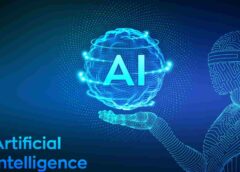How can digital processes be optimized and get the best out of the existing data? A white paper from Iron Mountain explores this question and discusses how companies can use AI profitably for their digital business processes.
Digital versus analogue. In the data management of numerous companies, these terms no longer exist as opposite poles. The advancing digitization means that companies are not only making their product portfolio more digital or adapting their sales channels. Business processes such as personnel management or the incoming mail are also increasingly being digitized.
However, physical data in paper form is still a reality in many cases – and a necessary one at that. Documents such as certificates or annual financial statements are subject to a storage period of ten years. Accordingly, companies have to think about physical documents when planning and designing business processes. Nevertheless, the potential of the digitization of certain processes should definitely be exploited.
But what if they went one step further? What if the employees no longer had to worry about files being destroyed in accordance with data protection regulations at the end of the retention period? Or that personal data in contracts and invoices would be automatically blacked out if required by the General Data Protection Regulation (GDPR)? If information sources of any kind could be analyzed and classified according to your specifications?
This next, logical step is: integrating artificial intelligence (AI). With the help of a wide variety of AI modules, companies can optimize their digital processes and get the best out of their data.
Artificial intelligence – Buzzword Or Useful Tool?
Artificial intelligence is a collective term for algorithms of different levels of complexity, which are intended to approximate human thinking in order to analyze information and independently develop solution decisions for problems. Machine learning (ML), for example, falls under AI. With machine learning, the AI uses structured training data to recognize patterns in the data set, which are later used to solve problems independently. A possible scenario for using machine learning is the automatic classification of documents, based on a ready-made training set that contains different types of documents, such as invoices or contracts. An ML application uses fewer resources than more complex AI solutions.
Another form of AI, deep learning, is suitable for more complex tasks such as video analysis. Deep learning solutions are based on artificial neural networks. These neural networks are mathematical algorithms that are modeled on the networked neurons of the human brain. The neural networks consist of an input level, several hidden levels (the so-called “hidden layers”) and the output level. An example of a deep learning application is image or video analysis or natural language processing (NLP), where the AI processes and analyzes natural language. As an output, the neural network can then make a decision such as: “It is 98 percent object xy” or in the case of NLP: “The language used indicates dissatisfaction”. With the help of NLP, users can examine texts for their tonality, for example. It is also important to note at this point that it is not yet possible to determine which calculations are carried out by the “hidden layers”. To better classify the output, the AI provides results with a confidence, such as the percentage above.
In order to create a basis of trust for the results of deep learning solutions, research is increasingly devoted to the concept of Explainable AI (xAI). In the context of “explainable artificial intelligence”, various methods are used to reduce the black box character of complex neural networks and thus make it easier to understand how the networks come to their decisions. This is very important, especially when it comes to decisions that affect people (e.g. court decisions or sentences).
Deep learning applications, just like ML applications, need to be trained. Depending on the type, deep learning networks can also train themselves or train other networks. The more “hidden layers” the neural network has, the more resource-intensive the training is, especially with regard to hardware utilization. In addition, each AI application, whether machine learning or deep learning, can only process one assigned task. For example, despite intensive training, a deep learning solution cannot simultaneously analyze the visual content of videos and translate the audio track at the same time – two different systems are required for this.
Train, Train, Train
Training an AI solution is central to the success or failure of the application, as the training sets provide the foundation for the AI to reliably perform its task. There are several ways to train an AI, which the AI uses to develop either statistical models or neural networks. Machine learning applications are trained with more structured data sets. Deep learning solutions, on the other hand, can also process extremely unstructured data, such as a random selection of photos in the case of image recognition. The data sets must be selected with corresponding care. This is especially true because an improperly structured training data set or an incomplete data set missing certain cases leads to a bias,
Companies that have decided to use AI can train simpler scenarios such as the classification of documents themselves. At the latest for more complex tasks, however, it makes sense to use a service provider who already has experience in compiling customer-specific training data sets. External service providers can also help to compile a data set according to certain requirements. If an AI solution is successfully set up, there are significant advantages for companies from the synergy of AI and digitized business processes:
- Save costs and time: AI solutions can support employees in time-consuming and labor-intensive processes and in decision-making, for example in classifying and archiving contracts and invoices
- Reduce error rates: AI-based solutions eliminate human error and improve accuracy – provided correct training is provided – especially in routine processes.
- Powerful analyzes and greater added value: Functions such as NLP can also carry out complex analyzes in routine processes such as viewing the inbox and thus, for example, qualify e-mails based on the tonality or content and forward them to the appropriate employees. In this scenario, NLP can also suggest suitable answers to employees or automatically answer clearly identified inquiries.
- Reliably comply with legal requirements: A correctly trained AI can support complex deletion processes, for example within the framework of the GDPR, by suggesting documents for deletion to the responsible employees. In this way, the compliance of a company can be secured more reliably and with less use of resources.
In summary, companies can gain a significant competitive advantage over their competitors with the help of AI solutions. AI is therefore not just a pure buzzword and should be taken into account accordingly in business decisions. Despite all the advantages, an AI is still a tool that can only create real added value if it is used strategically. Even simple AI applications can be of great benefit. However, a case-by-case analysis is always necessary to determine which processes should be supported by artificial intelligence.
Also Read: Top 10 Reasons Why Your Business Fails!
How To Integrate AI Into Processes?
When a company decides to implement an AI solution, it not only has the choice between the different forms of artificial intelligence. The variety of providers that are now on the market is also large. Global players such as Google or Amazon Web Services make their AI platforms available primarily to companies. Companies can then independently implement AI applications on these platforms: This offer format is therefore AI as a Service (AIaaS). In addition to the pure technology providers, there are also service providers.
If companies decide to implement an AI solution together with an external partner, the first step is to define the goal. Which process do I want to optimize with the help of AI and which goal do I want to achieve? An individual analysis and cost-benefit assessment follows, because not every process is suitable for being taken over or supported by an AI. If the decision is made in favor of an AI solution, the external experts work together with the company on the technological implementation. This includes, among other things, the selection of machine or deep learning models and more specifically the question of which analyzes the AI should carry out. As mentioned above, training the algorithms is a sensitive and critical part of the AI implementation.




